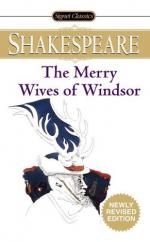|
This section contains 5,229 words (approx. 18 pages at 300 words per page) |

|
SOURCE: “The Merry Wives of Windsor: Classical and Italian Intertexts,” in Comparative Drama, Vol. 27, No. 3, Fall, 1993, pp. 364-76.
In the following essay, Miola asserts that despite its weaknesses in plot, The Merry Wives of Windsor reveals Shakespeare's skill at adapting comedic forms outside of English dramaturgy.
Current theory has distinguished between two opposite intertextual perspectives, synchronic and diachronic. Dismissing all notion of temporality and hence of sources, the synchronic perspective views all texts as existing simultaneously with each other. “An endless ars combinatoria takes place in what has been variously termed ‘musée imaginaire’ (Malraux), ‘chambre d'échos’ (Barthes), or ‘Bibliothèque générale’ (Grivel).” Contrarily, the diachronic perspective recognizes temporality and thus constructs well-ordered “archives” (Foucault) of intertextuality that meticulously chronicle “every code and register its continuities and discontinuities.”1 The latter perspective opposes the former's endless Derridean deferral and dispersion, that kind of detheologized hermeticism in...
|
This section contains 5,229 words (approx. 18 pages at 300 words per page) |

|


